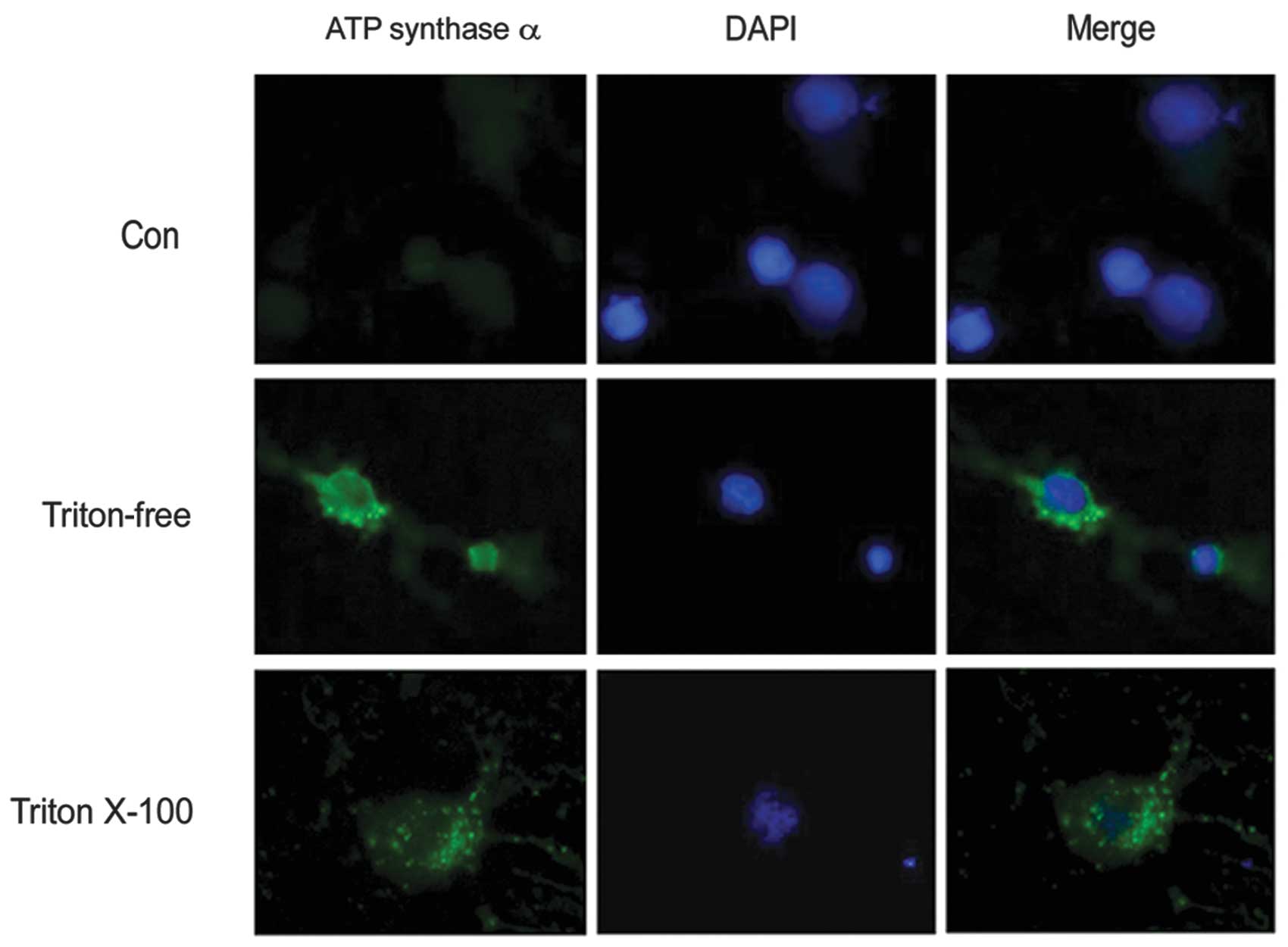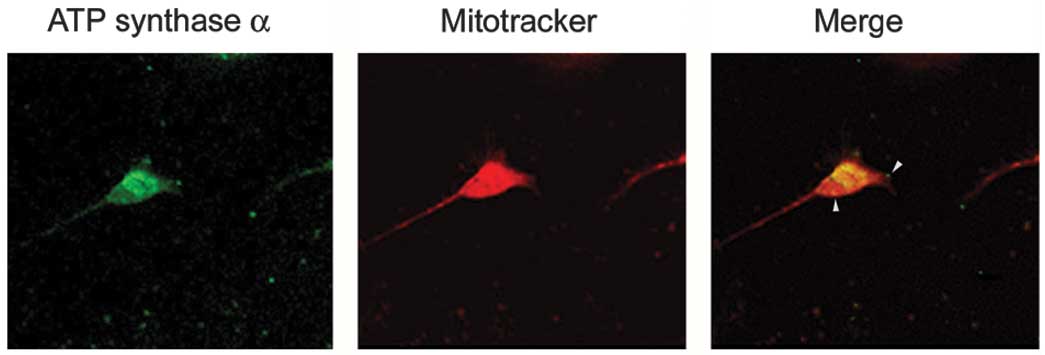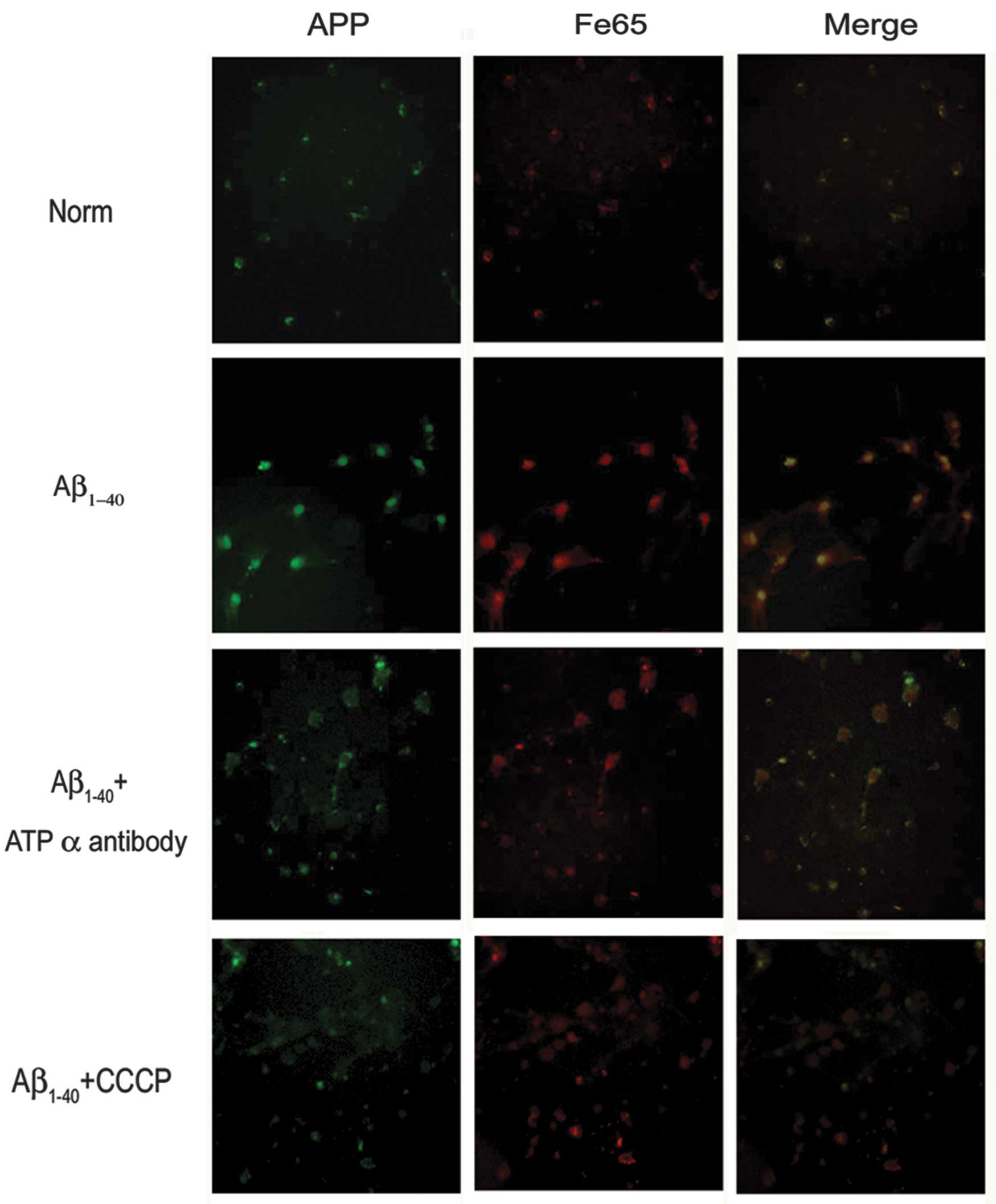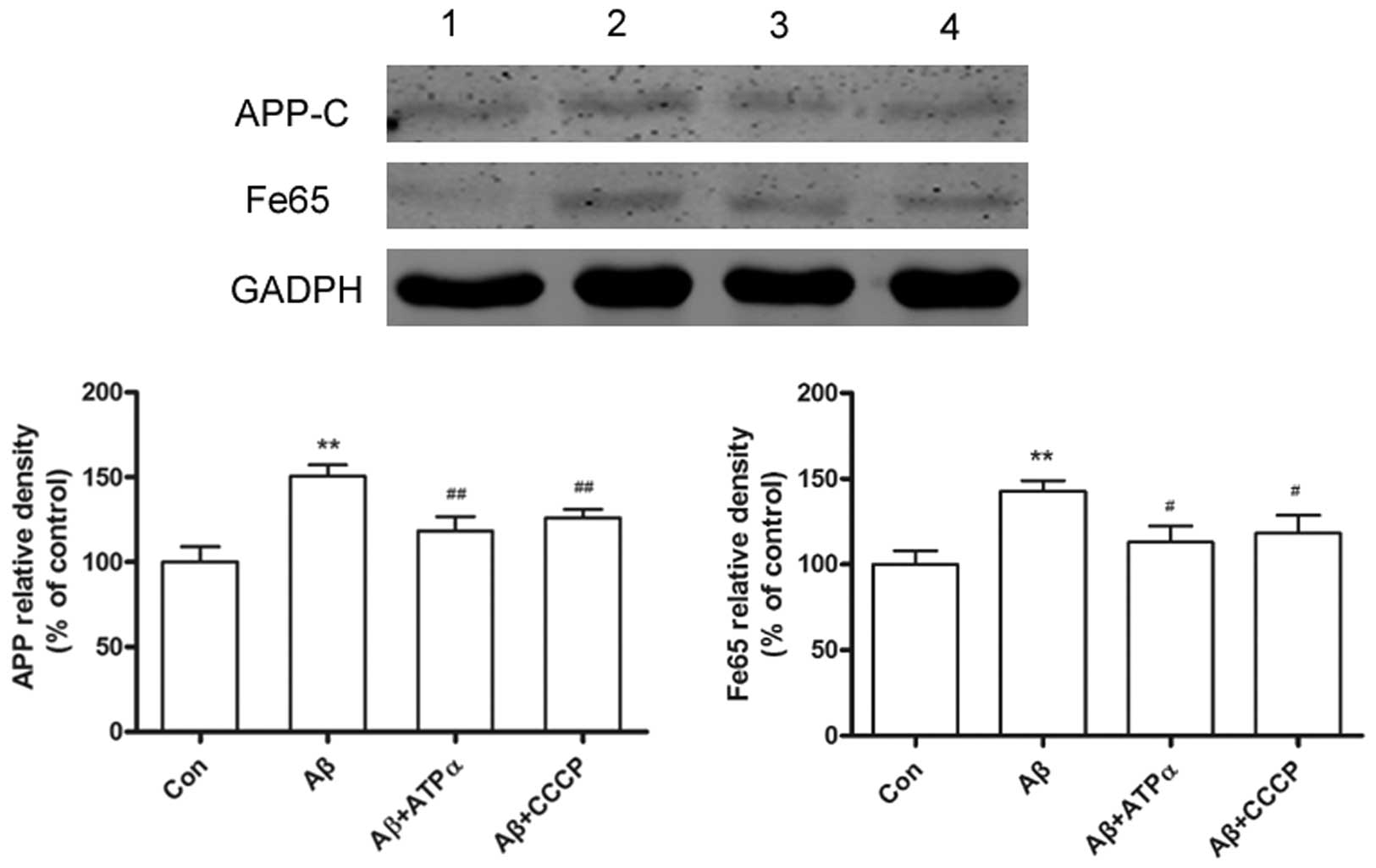Regulation of neuronal toxicity of β‑amyloid oligomers by surface ATP synthase
- Authors:
- Published online on: October 11, 2013 https://doi.org/10.3892/mmr.2013.1722
- Pages: 1689-1694
Abstract
Introduction
Alzheimer disease (AD) is a progressive neurodegenerative disease. The pathological features of AD include senile plaque deposits and neurofibrillary tangles. The major constituent of senile plaques is amyloid-β (Aβ) peptides, which are generated as cleavage fragments by the action of γ and β secretase on the amyloid precursor protein (APP) metabolism. Due to their inherently disordered and ‘sticky’ nature, the resulting Aβ peptides easily aggregate into oligomers, then fibrils and mature plaques in the brain (1). A previous study suggested that Aβ oligomers are the most toxic form of Aβ peptide and are critical in inducing cognitive impairment and synaptic dysfunction (2), however, the cell mechanisms of Aβ oligomer-mediated neurotoxicity are poorly defined. Experimental evidence supports the hypothesis that the disease process starts with the binding of oligomeric assemblies of Aβ to proteins on the surface of nerve cells (3). The identity of the molecules to which oligomers of Aβ bind to remains largely enigmatic. A number of binding proteins of Aβ have been identified on the neuron cell surface, including the N-methyl-D-aspartate receptor (4), integrins and the α7 nicotinic acetylcholine receptor (5).
ATP synthase, traditionally studied in the mitochondria, where it generates the majority of cellular ATP, has also been detected on the plasma membranes of several cell types (6,7). The ecto-ATP synthase serves as a multi-ligand receptor to regulate specific biological effects (8–10). Therefore, it was valuable to study the properties of ATP synthase on the neuronal surface, which have yet to be clearly elucidated. In a previous study, it was found that the presence of ATP synthase on the neuronal surface is responsible for the production of extracellular ATP (11) and that the cell surface ATP synthase α is a binding protein for Aβ on neural cells. Previous observations have demonstrated a novel function for Aβ in regulating ATP synthase activity through interaction with the α subunit of ATP synthase (12).
In the present study, the effect of the exogenous addition of oligomeric Aβ on neuronal cells and its effect on the APP/Fe65 signaling pathway was observed. ATP synthase was confirmed to be located on the surface of neuron cells and oligomeric Aβ was observed to induce neuron damage by LDH release, which originated from the breakdown in the integrity of the plasma membrane. From these observations, the expression of APP and Fe65 following oligomeric Aβ treatment was studied. Results showed that inhibition of the surface ATP synthase may reduce the neuronal damage and decrease APP and Fe65 expression. These results confirmed that the cell surface ATP synthase has a pathophysiological role in Aβ-induced neuronal toxicity.
Materials and methods
Cell culture
Cortices of embryos were obtained from pregnant Sprague-Dawley E16–E17 rats (Experimental Animal Center of Shanghai University of Traditional Chinese Medicine) and dissociated with 0.125% trypsin for 10 min at 37°C, then fetal bovine serum (FBS) was added to halt trypsinization. Cell suspensions were filtered through stainless steel mesh filter and centrifuged for 6 min at 555 × g. The cells were plated onto poly-L-lysine-coated plates or dishes according to the manufacturer’s instructions with Dulbecco’s modified Eagle’s medium (Gibco-BRL, Carlsbad, CA, USA) and supplemented with 10% FBS. Following 24 h, the medium was replaced with Neurobasal medium containing B27 supplement. Cultures were maintained for 8–10 days. Experiments were performed according to the Guide for the Care and Use of Medical Laboratory Animals (Ministry of Health, China, 1998) and the guidelines of the Shanghai University of Traditional Chinese Medical Laboratory Animal Care and Use Committee.
Preparation of aggregated Aβ1–40 and electron microcopy
Aggregates of Aβ1–40 were produced by dissolving a peptide in ddH2O to 700 μM, immediately diluting in PBS to 350 μM and incubating at 37°C for 7 days. The aggregated states were checked by electron microscopy. Briefly, Aβ1–40 solution was absorbed onto a carbon-coated copper grid and stained negatively with 1% phosphotungstic acid. Following drying, images were captured by electron microscopy (JEM-2100, JEOL, Tokyo, Japan) operating at 120 kV.
LDH release assay
Neurotoxicity of Aβ was evaluated by analyzing LDH content in culture medium. Neuronal cells were seeded in 96-well plates and 1% Triton X-100 was used as a positive control. Supernatant (50 μl) was transferred to a fresh 96-well plate and an equal volume of freshly prepared reaction mixture was added at 37°C for 10 min and 0.1 M citric acid 20 μl was added to end the reaction. The absorbance was measured at 570 nm.
Immunofluorescence staining
The mitochondria of primary cultured neurons on coverslips were first labeled by incubating with a mitochondrial dye, the Mitotracker (GenMed Scientifics Inc., Shanghai, China), then the cells were fixed with 4% paraformaldehyde for 30 min at room temperature and blocked in 5% BSA for 30 min with or without 0.2% Triton X-100. The cells were incubated with the primary antibodies with or without 0.2% Triton X-100, including anti-ATP synthase α, anti-APP-C (both 1:200; BD Biosciences, San Jose, CA, USA) and anti-Fe65 (1:200; Santa Cruz Biotechnology, Inc., Dallas, TX, USA), overnight at 4°C. After being washed three times with 0.01 M PBS, the cells were incubated with FITC or Texas Red-conjugated secondary antibodies (1:200; Santa Cruz Biotechnology, Inc.) at 37°C for 1 h. For nuclear staining, the cells were incubated with 2 μg/ml DAPI for 5 min at 37°C, washed three times and fluorescence signals were detected by confocal laser scanning microscopy (TCS-SP2; Leica, Wetzlar, Germany) or observed under a fluorescence microscope (BX51; Olympus, Tokyo, Japan).
Western blot analysis
Total protein was extracted and the concentration in samples was determined by Micro-BCA protein assay (Pierce Biotechnology Inc., Rockford, IL, USA). Samples were resolved by SDS-PAGE and transferred onto polyvinylidene fluoride membranes. The membranes were incubated with primary antibodies anti-APP-C (1:1,000), anti-Fe65 (1:1,000) and anti-GADPH (1:5,000; all Abcam, Cambridge, MA, USA) at 4°C overnight. Following washing, the membranes were incubated with horseradish peroxidase-conjugated secondary antibodies for 1 h at room temperature. Blots were visualized by enhanced chemiluminescence.
Statistical analysis
Statistical analysis was performed using GraphPad Prism version 5 (GrahPad Software, San Diego, CA, USA). Measurement data are expressed as mean ± SD. Differences were assessed using the Student’s t-test for comparisons. P<0.05 was considered to indicate a statistically significant difference.
Results
Effect of Aβ on the viability of primary cortical neuron by ATP synthase
To confirm the oligomer state of Aβ aggregates, electron microscopy was used to probe the aggregation. Robust fibrils were primarily observed (Fig. 1A). Increasing activity of LDH released from cells into culture medium also indicated the damage to neurons. LDH activity was assayed in the supernatant of the control, exposed to Aβ1–40 (5 μmol/l) and treated with anti-ATP synthase α antibody (0.25 μg/ml) or CCCP (1 μg/ml) in the presence of Aβ groups. The results showed that Aβ treatment promoted more LDH release compared with the control group. Furthermore, the data suggested that groups exposed to anti-ATP synthase α antibody or CCCP in the presence of Aβ had significantly lower leakage of LDH, indicating that the cytotoxicity of Aβ on the neuron may be occurring through the neuronal surface ATP synthase pathway (Fig. 1B).
ATP synthase is located on the cell surface of primary cultured neurons
In a previous study (11) it was suggested that the expression of the ATP synthase complex is located on the neuronal surface. In the present study, the primary cultured neurons were immunostained with anti-ATP synthase α antibody with or without Triton X-100. The results demonstrated that subunits of ATP synthase were distributed on the neuronal cell body as well as on the surface (Fig. 2). To confirm that the expression of ATP synthase complex is on the neuronal surface, live neurons prelabeled with Mitotracker were immunostained with an anti-ATP synthase α antibody. Triton X-100, which is commonly used to permeabilize cells, was omitted to decrease the antibody in the neuron. The results showed that the α subunits of ATP synthase appeared as a punctate distribution on the neuronal surface (Fig. 3).
Aβ inhibits the APP expression levels through neuronal surface ATP synthase
In the current study, primary neuronal cultures exposed to Aβ led to an increase in APP expression levels. The adaptor protein Fe65 has been shown to mediate APP metabolism and increase Aβ production, thus the present study showed that exposure to Aβ, led to an increase in Fe65 levels. However, immunofluorescence studies showed that groups exposed to the anti-ATP synthase α antibody or CCCP in the presence of Aβ had significantly decreased APP and Fe65 levels (Fig. 4). To determine the inhibition of neuronal surface ATP synthase α, the APP and Fe65 levels were analyzed following pretreatment with the ATP synthase α antibody or CCCP in the presence of Aβ on cultured neurons by western blot analysis. Results showed that the cytotoxicity of Aβ on the primary cultured neuron was regulated by neuronal surface ATP synthase α (Fig. 5).
Discussion
Aβ is the primary component of amyloid deposits in AD, which is capable of interacting with a number of molecular partners and regulating its activity (13,14). The cell surface is the first site of interaction between extracellular Aβ and neurons. Our previous study (11) showed that ATP synthase was present on the surface of cultured neural cells and demonstrated that the α-subunit of ATP synthase was located in the senile plaques of APP/PS1 transgenic mice and co-labeled with Aβ. Cell surface ATP synthase acts to bind a number of ligands and to trigger hydrolysis or synthesis of ATP, lipid metabolism and cell death. In contrast to the studies of surface ATP synthase on hepatocytes and endothelial cells (15,16), ATP synthase on neurons has been less studied. For instance, the α-subunit of ATP synthase not only co-deposits with neurofibrillary tangles in Alzheimer’s disease, but also binds with amyloid-β peptide and the amyloid precursor protein and it appears that ecto-ATP synthase may be involved in neurodegeneration (17,18).
APP is an integral membrane protein from which the β-amyloid peptide is generated. APP was hypothesized to be involved in the signal transduction processes, due to its transmembrane structure (19). The Fe65 gene is primarily expressed in the neurons of specific regions of the mammalian nervous system and encodes a protein containing two types of protein-protein interaction domains: the WW domain and the phosphotyrosine interaction/phosphotyrosine binding (PID/PTB) domain. The PID/PTB domains were demonstrated to interact with the intracellular domain of APP (20). By overexpression or knockdown, Fe65 has been shown to modulate APP metabolism, increase APP translocation to the plasma membrane, which was accompanied by an increase in Aβ production and sAPP secretion (21,22). Thus, it was hypothesized that the APP changes may affect the interaction with Fe65.
The current observations suggest that Aβ affects an increase in APP production and Fe65 by binding to the surface ATP synthase. Schmidt et al indicated that APP binds surface ATP synthase and that the binding sequence of APP is similar to the ATP synthase binding sequence of the inhibitor of F1, a naturally occurring inhibitor of the ATP synthase complex in mitochondria (18). A physiologically relevant negative feedback mechanism is hypothesized to be operating, closely coordinating the levels of APP expression, surface ATP synthase and Aβ production. Fe65 was first shown to interact with APP in a yeast two-hybrid system (23). A previous study showed that Fe65 binds directly to the cytoplasmic domain of APP through its carboxyl-terminal-phosphotyrosine interaction domains subsequently (20). The current observations are in agreement with an important role of surface ATP synthase in Aβ-mediated neurotoxicity and hypothesize that one of the mechanisms that play a role in the neurodegenerative processes are observed in AD. However, the surface ATP synthase trigger neuronal stress mechanisms in the presence of Aβ require further investigation.
Acknowledgements
The study was supported by grants from the Shanghai Health Bureau Youth Fund (no. 20114Y104) and the Innovation Program of Shanghai Municipal Education Commission (no: 09YZ118).
References
|
Kayed R, Head E, Thompson JL, et al: Common structure of soluble amyloid oligomers implies common mechanism of pathogenesis. Science. 300:486–489. 2003. View Article : Google Scholar : PubMed/NCBI | |
|
Fifre A, Sponne I, Koziel V, et al: Microtubule-associated protein MAP1A, MAP1B, and MAP2 proteolysis during soluble amyloid beta-peptide-induced neuronal apoptosis. Synergistic involvement of calpain and caspase-3. J Biol Chem. 281:229–240. 2006. View Article : Google Scholar | |
|
Selkoe DJ: Soluble oligomers of the amyloid beta-protein impair synaptic plasticity and behavior. Behav Brain Res. 192:106–113. 2008. View Article : Google Scholar : PubMed/NCBI | |
|
You H, Tsutsui S, Hameed S, et al: Aβ neurotoxicity depends on interactions between copper ions, prion protein, and N-methyl-D-aspartate receptors. Proc Natl Acad Sci USA. 109:1737–1742. 2012. | |
|
Verdier Y, Zarándi M and Penke B: Amyloid beta-peptide interactions with neuronal and glial cell plasma membrane: binding sites and implications for Alzheimer’s disease. J Pept Sci. 10:229–248. 2004.PubMed/NCBI | |
|
Kim BW, Choo HJ, Lee JW, Kim JH and Ko YG: Extracellular ATP is generated by ATP synthase complex in adipocyte lipid rafts. Exp Mol Med. 36:476–485. 2004. View Article : Google Scholar : PubMed/NCBI | |
|
Burrell HE, Wlodarski B, Foster BJ, et al: Human keratinocytes release ATP and utilize three mechanisms for nucleotide interconversion at the cell surface. J Biol Chem. 280:29667–29676. 2005. View Article : Google Scholar : PubMed/NCBI | |
|
Champagne E, Martinez LO, Collet X and Barbaras R: Ecto-F1Fo ATP synthase/F1 ATPase: metabolic and immunological functions. Curr Opin Lipidol. 17:279–284. 2006. View Article : Google Scholar : PubMed/NCBI | |
|
Mowery YM and Pizzo SV: Targeting cell surface F1F0 ATP synthase in cancer therapy. Cancer Biol Ther. 7:1836–1838. 2008. View Article : Google Scholar : PubMed/NCBI | |
|
Vantourout P, Radojkovic C, Lichtenstein L, Pons V, Champagne E and Martinez LO: Ecto-F1-ATPase: a moonlighting protein complex and an unexpected apoA–I receptor. World J Gastroenterol. 16:5925–5935. 2010. | |
|
Xing SL, Yan J, Yu ZH and Zhu CQ: Neuronal cell surface ATP synthase mediates synthesis of extracellular ATP and regulation of intracellular pH. Cell Biol Int. 35:81–86. 2011.PubMed/NCBI | |
|
Xing SL, Chen B, Shen DZ and Zhu CQ: β-amyloid peptide binds and regulates ectopic ATP synthase α-chain on neural surface. Int J Neurosci. 122:290–297. 2012. | |
|
Magdesian MH, Carvalho MM, Mendes FA, et al: Amyloid-beta binds to the extracellular cysteine-rich domain of Frizzled and inhibits Wnt/beta-catenin signaling. J Biol Chem. 283:9359–9368. 2008. View Article : Google Scholar : PubMed/NCBI | |
|
Shaked GM, Kummer MP, Lu DC, Galvan V, Bredesen DE and Koo EH: Abeta induces cell death by direct interaction with its cognate extracellular domain on APP (APP 597–624). FASEB J. 20:1254–1256. 2006.PubMed/NCBI | |
|
Fabre AC, Vantourout P, Champagne E, et al: Cell surface adenylate kinase activity regulates the F(1)-ATPase/P2Y (13)-mediated HDL endocytosis pathway on human hepatocytes. Cell Mol Life Sci. 63:2829–2837. 2006. View Article : Google Scholar | |
|
Martinez LO, Jacquet S, Esteve JP, et al: Ectopic beta-chain of ATP synthase is an apolipoprotein A–I receptor in hepatic HDL endocytosis. Nature. 421:75–79. 2003. | |
|
Sergeant N, Wattez A, Galván-valencia M, et al: Association of ATP synthase alpha-chain with neurofibrillary degeneration in Alzheimer’s disease. Neuroscience. 117:293–303. 2003.PubMed/NCBI | |
|
Schmidt C, Lepsverdize E, Chi SL, et al: Amyloid precursor protein and amyloid beta-peptide bind to ATP synthase and regulate its activity at the surface of neural cells. Mol Psychiatry. 13:953–969. 2008. View Article : Google Scholar : PubMed/NCBI | |
|
Guénette SY, Chen J, Jondro PD and Tanzi RE: Association of a novel human FE65-like protein with the cytoplasmic domain of the beta-amyloid precursor protein. Proc Natl Acad Sci USA. 93:10832–10837. 1996.PubMed/NCBI | |
|
Zambrano N, Buxbaum JD, Minopoli G, et al: Interaction of the phosphotyrosine interaction/phosphotyrosine binding-related domains of Fe65 with wild-type and mutant Alzheimer’s beta-amyloid precursor proteins. J Biol Chem. 272:6399–6405. 1997.PubMed/NCBI | |
|
Ando K, Iijima KI, Elliott JI, Kirino Y and Suzuki T: Phosphorylation-dependent regulation of the interaction of amyloid precursor protein with Fe65 affects the production of beta-amyloid. J Biol Chem. 276:40353–40361. 2001. View Article : Google Scholar : PubMed/NCBI | |
|
Xie Z, Dong Y, Maeda U, Xia W and Tanzi RE: RNA interference silencing of the adaptor molecules ShcC and Fe65 differentially affect amyloid precursor protein processing and Abeta generation. J Biol Chem. 282:4318–4325. 2007. View Article : Google Scholar : PubMed/NCBI | |
|
Fiore F, Zambrano N, Minopoli G, Donini V, Duilio A and Russo T: The regions of the Fe65 protein homologous to the phosphotyrosine interaction/phosphotyrosine binding domain of Shc bind the intracellular domain of the Alzheimer’s amyloid precursor protein. J Biol Chem. 270:30853–30856. 1995.PubMed/NCBI |














